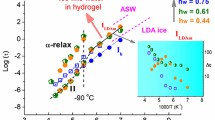Abstract
Bulk water exists in three phase states: crystalline solid, liquid and vapor. Phase transitions between these states are brought about by changes in the physical environment such as temperature and pressure. Each phase of water is characterized by differences in translational and rotational motion of the water molecule. For example, water molecules in ice move one million times slower than in the liquid state. Does this adequately describe behavior of water at the multitude of surfaces in the cell? A molecular model of four water of hydration subcompartments on tendon/collagen, on globular proteins and in a cell is presented. Each subcompartment is defined in terms of compartmental protein hydration capacities, compartmental water motional restrictions and related descriptors. The range of water molecule motional activity in biological systems are described by correlation times that range from that of ice at 10-6 s to bulk water at 10-12 s. The existence and size of water subcompartments with intermediate motional and other properties has been measured by proton NMR titration, differential scanning calorimetry, centrifugal dehydration force flow rate, isotherm rehydration and osmotic behavior. In addition sub-compartment capacities can be predicted by molecular modeling. The molecular model of water subcompartments first developed for tendon/collagen appears generally applicable for globular proteins and for human erythrocytes. However, changes in protein conformation and aggregation cause changes in the size of the outer-most sub-compartments. Such changes bring about changes in the physical and physiological properties of cellular water. This growing awareness of the role of water subcompartments in explaining cellular activities is predicted to have a revolutionary effect on cell biology.
Access this chapter
Tax calculation will be finalised at checkout
Purchases are for personal use only
Preview
Unable to display preview. Download preview PDF.
Similar content being viewed by others
References
Cameron, I.L., Ord, V.A., Fullerton, G.D., 1988, Water of hydration in the intra- and extra-cellular environment of human erythrocytes. Biochemistry & Cell Biology66(11):1186–1199.
Cameron, I.L., Cox, L.A., Liu, X.R., Fullerton, G.D., 1991, Maintenance and mobility of hemoglobin and water within the human erythrocyte after detergent disruption of the plasma membrane, Journal of Cellular Physiology 149:362–372.
Cameron, I.L., Kanal, K.M., Keener, C.R., Fullerton, G.D., 1997, A mechanistic view of the non-ideal osmotic and motional behavior of intracellular water. Cell Biology International21(2):99–113.
Cameron, I.L., Short, N., Fullerton, G.D., 2007b, A centrifugal dehydration force method for characterizing water compartments in fresh and postmortem fish muscle.Cell Biology International31: 516–526.
Cameron, I.L., Short, N., Fullerton, G.D., 2007a, Verification of simple hydration/dehydration methods to characterize multiple water compartments on tendon type 1 collagen. Cell Biology International31: 531–536.
Fullerton, G.D., Amurao, M.R., 2006, Evidence that collagen and tendon have monolayer water coverage in the native state. Cell Biology International30(1):56–65.
Fullerton, G.D., Cameron, I.L., 2006, On the osmotically unresponsive water compartment in cells. Cell Biology International 30(1):74–77.
Fullerton, G.D., Ord, V.A., Cameron, I.L., 1986, An evaluation of the hydration of lysozyme by an NMR titration method. Biochimica et Biophysica Acta 869:230–46.
Fullerton, G.D., Rahal, A., 2007, Collagen structure: the molecular source of tendon magic angle effect. Journal of Magnetic Resonance Imaging 25: 345–361.
Fullerton, G.D., Nes, E., Amurao, M., Rahal, A., Krasnosselskaia, L., Cameron, I.L., 2006a, An NMR method to characterize multiple water compartments on mammalian collagen. Cell Biology International30(1):66–73.
Fullerton, G.D., Kanal, K.M., Cameron, I.L., 2006b, Osmotically unresponsive water fraction on proteins: Non-ideal osmotic pressure of bovine serum albumin as a function of pH and salt concentration. Cell Biology International30(1):78–85.
Goodsell, D.S., 1991, Inside a living cell. Trends in Biochemical Sciences 16:203–206.
Hori T., 1956, No. 62, US Army, Snow, Ice and Permafrost Res. Establishment. Low Temperature ScienceA15:34.
Ling, G.N., 1972, Hydration of macromolecules. In Water and Aqueous Solutions: Structure, Thermodynamics and Transport Processes(R.A. Horne, ed.), Wiley Interscience, New York, USA, pp. 663–700.
Ling, G.N., 2004, What determines the normal water content of living cells? Physiological Chemistry & Physics and Medical NMR 36:1–19.
Ling, G.N., 2001, Life at the Cell and Below-Cell Level: the Hidden History of a Fundamental Revolution in Biology. (G.N. Ling, ed.), Pacific Press, New York, USA.
Ling, G.N., Negendank, W., 1970, The physical state of water in frog muscle. Physiological Chemistry & Physics & Medical NMR2:15–23.
Pollack, G.H., 2001, Cells, Gels and the Engines of Life: A New Unified Approach to Cell Function. (G.H. Pollack, ed.), Ebner & Sons, Seattle, USA.
Urry, D.W., 1995, Elastic biomolecular machines: synthetic chains of amino acids, patterned after those in connective tissue, can transform heat and chemical energy into motion. Scientific American 272: 64–69.
Zheng, J., Pollack, G.H., 2006, Solute exclusion and potential distribution near hydrophilic surfaces. In Water and the Cell (G.H. Pollack, I.L. Cameron, D.N. Wheatley, eds.) Springer Dordrecht, The Netherlands, pp. 165–174.
Author information
Authors and Affiliations
Editor information
Editors and Affiliations
Rights and permissions
Copyright information
© 2008 Springer Science+Business Media B.V.
About this chapter
Cite this chapter
Cameron, I., Fullerton, G. (2008). Interfacial Water Compartments on Tendon/Collagen and in Cells. In: Pollack, G.H., Chin, WC. (eds) Phase Transitions in Cell Biology. Springer, Dordrecht. https://doi.org/10.1007/978-1-4020-8651-9_3
Download citation
DOI: https://doi.org/10.1007/978-1-4020-8651-9_3
Publisher Name: Springer, Dordrecht
Print ISBN: 978-1-4020-8650-2
Online ISBN: 978-1-4020-8651-9
eBook Packages: Biomedical and Life SciencesBiomedical and Life Sciences (R0)




